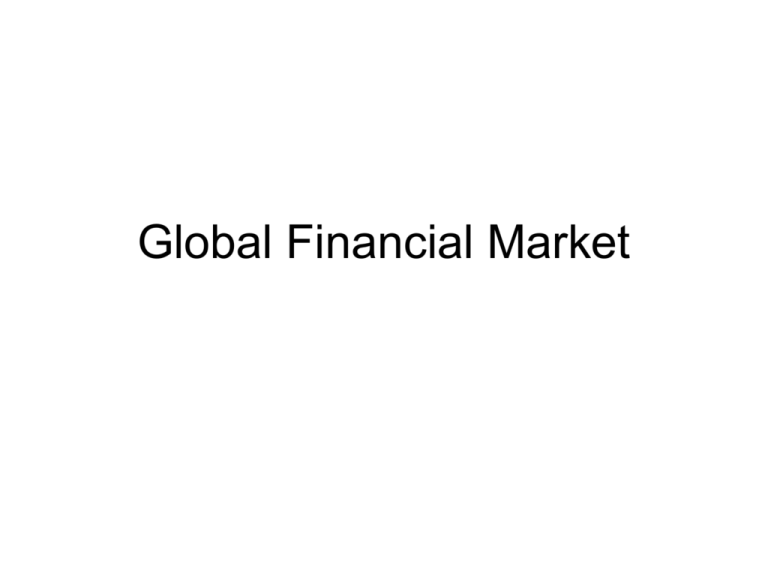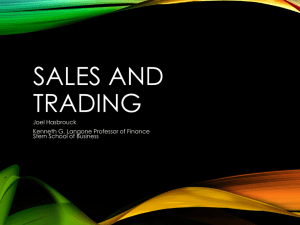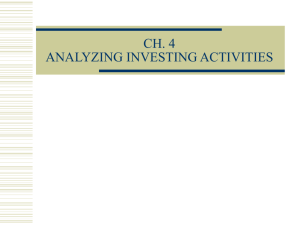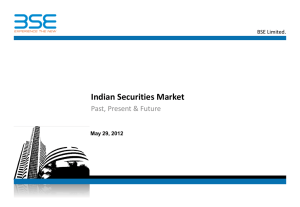Global Financial Markets (cont.)
advertisement

Global Financial Market Private Financial Intermediaries (FIs) • Private FIs: profit-seeking firms whose assets are predominantly financial. • Financial Intermediaries (FIs) are the professionals that guide us through our risk shifting and cash flow timing transactions in financial markets. Broker/Dealer Operations • Broker: FI that brings together buyers and sellers without acting as a principle in the transaction. • Dealer: FI that makes a market in a financial security, thereby participating as a principal in the financial transaction. • Market Maker or Specialists: Dealers that make a market in one or more number of securities and who maintain a “fair and orderly” market by dealing personally in the market. Other Operations of Private FIs • Underwriting: the process whereby the FI brings to market a newly issued financial security. • Asset Transformation: the FI’s creation of new financial securities by selling financial securities that are different from the financial securities it buys. • Securitization: the packaging of non-traded financial securities into a newly created tradable financial security. The Structure of Financial Markets • Two settings: 1. Formal Financial Exchanges 2. Over-the-counter (OTC) Markets • Financial Exchanges are formalized Trading Institutions. Only members have the right to trade in Fin. Exchanges. Each Financial Exchange has detailed and explicit rules governing the conduct of the trade of securities. Examples: NYSE: New York Stock Exchange CBOT: Chicago Board of Trade CME: Chicago Mercantile Exchange LIFFE: London International Financial Futures Exchange LSE: London Stock Exchange The Structure of Financial Markets (cont.) • Over The Counter (OTC) covers all other financial market transactions. In an OTC trade buyer or seller are free to negotiate all contractual details. Modern OTC markets rely on telephone and computer screens to link buyers and sellers with market dealers. Dealers quote both bid and ask prices to prospective buyers and sellers. • Examples: NASDAQ, FX Market NASDAQ: National Association of Securities Trader Automated Quotation FX Market: Foreign Exchange Inter-bank Market The Structure of Financial Markets (cont.) • Drivers of Liquidity: Manual vs. Automated trading systems Example 1: Trade in German Govt. Bond futures moved from LIFFE derivatives market to SwissGerman derivatives exchange EUREX Example 2: Flight from BBB to AA bonds in 1998 after Russian Default • Liquidity can also be created through the removal of credit (counterparty) risk. In the money market use of “Sale and Repurchase of Agreement’ or REPO is such an example. • Repo is a short-term contract when one party agrees to sell a security to another party (the lender) and then repurchase subsequently at a higher price. Clearing & Settlement Service • Process: Each party (say A&B) keeps cash in a Bank Account, known as Clearing Bank) and keeps his/her own securities in “securities accounts”. To settle a trade, the securities are taking out of party A’s account and deposited into party B’s account, while the cash is taking out of party B’s account and deposited into party A’s account. • Oldest method – messengers sent for confirmation (up to 50’s). Clearing & Settlement Service (cont.) • Depository Trust Company (DTC) in 60’s. • All parties have securities accounts with DTC and DTC keeps records of all transfers. • Other than the recording a trade, a trade confirmation is also required. In last 30 years, all clearing houses are consolidated as: • For equity trades: National Security Clearing Corporation (NSCC) • For all Fixed Income: Fixed Income Clearing Corporation (FICC) • Both NSCC and FICC, as well as DTC are subsidiaries of Depository Trust & Clearing Corporation (DTCC). • Today most trades are handled in an automated fashion from organization to settlement (called Straight through Processing, STP). Clearing & Settlement Service (cont.) • Regulations: • There are two types of regulation in securities market, one by legislation (through US government) and the other is self governing. After Great Depression and 1929 market crash, the Security Act helped to create SEC or Security Exchange Commission and Commodity Futures Trading Commission (CFTC in 1972) which are government agencies. • Non-government agencies/ self regulatory organizations: National Association of Security Dealers (NASC) National Futures Association (NFA) Bond Markets Association ( BMA) • Regulation and Compliance: • Whether self regulated or regulated by government, compliance is an important issue in every firm. Clearing & Settlement Service (cont.) Type of PFI 1. Buy-side companies: Professional Asset Management Companies (invest client’s money): Blackrock, PIMCO, BGI, Deutsche Asset Mgmt Mutual Fund Co. 2. Flagship Sell-side companies are: Goldman Sachs Morgan Stanley Lehman Bros Bear Sterns 3. Mutual Fund or Asset management companies. Fidelity Vanguard Clearing & Settlement Service (cont.) Commercial Bank and Investment Bank • 1930’s Glass Steagal Act d separated the Commercial Banking activity and Investment Banking activity. In 1990’s it changed and • Citibank bought Salomon Brothers • Chase bought JP Morgan • UBS • HSBC • Deutsche Bank • Credit Swiss Clearing & Settlement Service (cont.) Money is made in Private Financial Intermediaries • Investment Banking fees • Asset Management fees • Brokerage fees • Market making revenues • Proprietary trading revenues • Hedge Funds make money from asset management and proprietary trading • Dealers make money from Market making revenues and Proprietary trading revenues • Brokers make money from Brokerage fees. Global Financial Markets • • • • • 1700’s: London, Amsterdam, Paris, Antwerp Mid-1800’s: London, Amsterdam, Paris and New York Mid-1900’s: mainly New York 1990: London is back with New York, Tokyo 1990’s: PIMCO, BAI – west coast Florida, California USA New York Chicago +California +Florida Europe London Paris Frankfort Amsterdam Asia Tokyo Singapore Hong Kong Shanghai Bombay Australia Sydney Global Financial Markets (cont.) • Investment Banking Underwriting Bringing new securities to market Advising on Mergers & Acquisitions • Retail Brokerage – buy/sell securities for clients Maintain accounts for individual investments • Prime Brokerage – buy & sell to other brokers/ dealers • Asset Management – buy side activity • Equities / Fixed Income / Securities – Trading Global Financial Markets (cont.) • Trading groups are organized by type of customers. • Hedge Funds, Banks, Asset Managers, Corporations • Trading group include a Trader, Trading Assistants, Interns + some Quants And Technology people for support. • Trade Solicitation vs. Pricing securities vs. Closing Trade • Trading Books and manage p&L of the trading Desk • Bank Office or operations - reconciliation/clearing - netting - settling trades • Traders are supported by research group 1. Understand the existing Pricing Model 2. Develop programs that traders could run on their computers • All have Market Data Platforms (Bloomberg or Reuters) • Recent trend is Quantitative Risk Management Global Financial Markets (cont.) • Other Market Players 1. Portfolio Managers data mining task 2. Hedge Funds Use models and take risks (smaller operations) typically hires – quant traders • Quant traders need expertise in Excel modeling but knowledge of quantitative modeling and the knowledge of particular products are necessary. • Desk Quants creates and maintains quantitative models that are used in day to day trading activity. Desk Quants are an intermediary between trader and technology units. • Sales and Market Research • They provide research support to the sales people. Broader analysis of economic / political / and issues driving market. Global Financial Markets (cont.) Positions of hiring: • Analysts vs. Associates • VP vs. Directors • Managing director Sell Side Financial Intermediaries: Participants in Secondary Markets Dealer Dealer Inter Dealer Dealer Broker Exchanges NYSE Exchanges NASDAQ Broker I N V Exchanges FCN Broker E S Broker T O R S Organization Structure of a Sell Side Financial Intermediaries: TOP MANAGEMENT Legal / Compliance Revenue / Producing Technology Risk Management Investment Banking Equity Asset Management Fixed Income Retail / Prime Brokarage Foreign Exchange Rates Mortgages Credit Treasuries Munis Risk Management Int. Rate Derivatives Swaps Structured Products Market Participants: Firms Government General Motors Agencies US Treasury Goldman Sachs I FNMA World Banks Lehman Bros. N V Other FIs E S Citi Group T O R S Global Financial Markets Size of Different Global Financial Markets (Source: RPM Handbook) Table 1. Key Statistics for the Principle Global Equity Market 2002 Market Cap (End Yr) $ Trillion Average Daily Turnover $ Billion Average Transaction Value $ Thousand NYSE 9.0 40.9 19 NASDAQ 2.0 28.8 12 London Stock Exchange 1.8 15.9 105 Euronext 1.5 7.8 31 Tokyo 2.1 6.4 n/a Deutsche Borse 0.7 4.8 17 Other N. America 0.6 6.3 Other Europe 2.1 10.1 Emerging Markets 3.0 13.1 Total 22.8 134.0 Table 2. Stock of International and Domestic Market Debt, Sept. 2003 (US$ Trillion) All Maturities Remaining Maturities < 12M Domestic Internat’l Total Domestic Internat’l Government 18.1 1.1 19.2 4.1 0.1 4.2 Financial Institutions 15.5 7.8 23.2 4.0 1.4 5.4 Corporate Sector 4.9 1.4 6.3 0.6 0.2 0.8 Total 38.5 10.2 48.7 8.7 1.7 10.4 Total Table 3. Market Capitalization of Bonds Listed on Principal Exchanges (US $ Trillion) Luxembourg London Osaka NYSE Italy Domestic Public Sector 0.0 0.0 3.6 1.1 1.1 Domestic Private Sector 0.1 0.1 0.1 0.2 0.1 Foreign 4.8 0.6 0.0 0.1 0.0 Total 4.9 0.7 3.7 1.4 1.2 Table 4. Daily Foreign Exchange Turnover April 2001 (US$ Billion) Different Foreign Exchange Turnover Volume (US$ Billion) Markets Spot 387 Forward 131 Foreign Exchange Swap 656 Total 1173 Table 5. Major OTC Derivatives June 2003 Notional Amounts (US$ Trillion) Gross Market Values (US$ Billion) Interest Rate Swaps 94.6 1126 Interest Rate Options 16.9 434 Forward Rate Agreements 10.3 20 Currency Forwards and Currency Swaps 12.3 476 Currency Swaps 5.2 419 Currency Options 4.6 101 Equity Derivatives 2.8 260 Commodity Derivatives 1.0 110 Other Including Credit Derivatives 22.0 1083 Total 169.7 4029 Table 6. Principal Exchanges for Equity Derivatives Millions of Contracts Traded 2002 Individual Stock Options Equity Index Futures Options AMEX 150.7 32.7 BOVESPA (Sao Paolo Stock Exchange) 89.7 1.1 Chicago Board Options Exchange 173.2 94.4 Chicago Mercantile Exchange Futures 5.4 212.2 International Securities Exchange 152.3 EUREX 143.3 0.1 90.3 120.4 Euronext 323.6 7.6 108.3 51.9 Pacific SE 72.7 12.7 Philadelphia SE/BOT 84.9 3.6 World-Wide 1300.0 57.1 420.2 531.3 Notes: EUREX was formed joining DTB and SOFEX Euornext is a combination of Dutch and Paris exchanges DTB: Deutsche TerminBorse SOFEX: Swiss Options and Financial Futures Exchanges Table 7. Principal Exchanges for Fixed Income Derivatives Millions of Contracts Traded 2002 Chicago Board Options Exchange (CBOT) Government Debt Interest Rate Options Options 54.7 Futures 205.6 Chicago Mercantile Exchange (CME) EUREX 31.6 8.1 Korean Futures Exchange 12.8 1.6 7.7 105.6 202.5 42.7 149.2 415.0 Euronext Sydney Futures Exchange 21.7 Singapore Exchange 21.7 BM & P World-Wide Futures 89.1 677.5 2.5 48.6 151.2 532.5 Table 8. Principal Exchanges for Currency and Commodity Derivatives Millions of Contracts Traded 2002 Currency Options Commodity Futures Chicago Board Options Exchange (CBOT) Options Futures 12.6 54.1 0.8 6.8 New York Mercantile Exchange 26.4 107.3 London Metal Exchange 2.3 56.3 Chicago Mercantile Exchange (CME) 2.2 22.1 Zhenzhou Commodity Exchange 14.6 Tel Aviv SE 12.0 BM & P 2.0 16.1 World-Wide 16.7 41.1 47.8 265.2 Figure 2.1 Private Financial Intermediaries (FIs) Brokers Financial Securities Financial Securities Financial Securities Funds Surplus Units Shares Deposits Financial Securities Dealers Underwriters Investment bankers Mutual funds Pension funds Financial Securities Financial Securities Financial Securities Banks Financial Securities Insurance comp IOUs Non-intermediated Transactions (direct financing) Funds Deficit Units Opaque FIs Loans Policies Transparent FIs IOUs



